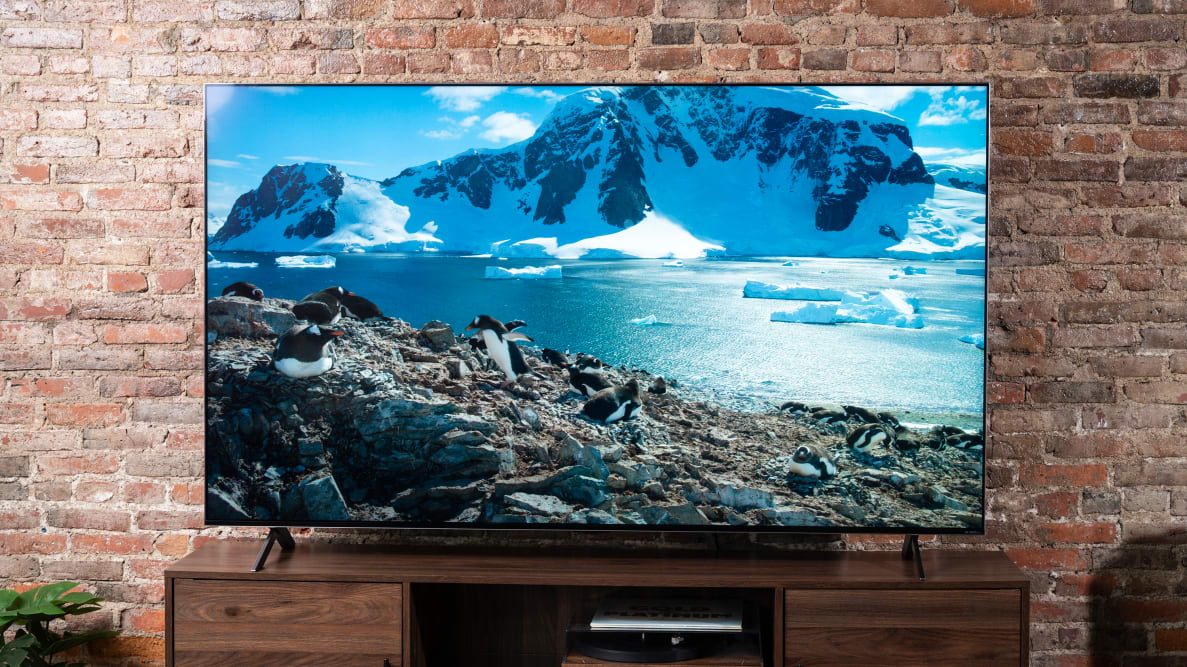Pros
-
Excellent brightness and overall contrast
-
Fetching design
-
Good upscaling
Cons
-
No Variable Refresh Rate
-
Sluggish software
-
Prone to light bloom
In order to achieve its eye-catching performance, the QNED99 blends mini-LED backlighting with quantum-dot color, which is where the moniker “QNED” comes from. Aside from a curious lack of Variable Refresh Rate, the QNED99 offers some future-facing features, including HDMI 2.1. That said, while its 8K resolution is certainly nice to hang your hat on, when you’re not experiencing native 8K content—which is most of the time—you’re left with a really great TV that isn’t quite as good as some of the best 4K TVs we’ve seen this year.
Make no mistake: The LG QNED99 is a bright, impressive-looking TV built for the future. In many ways, it’s a preview of what’s to come in the world of televisions. Just remember that you’re paying a premium for the privilege of that preview.
About the LG QNED99 8K TV Series
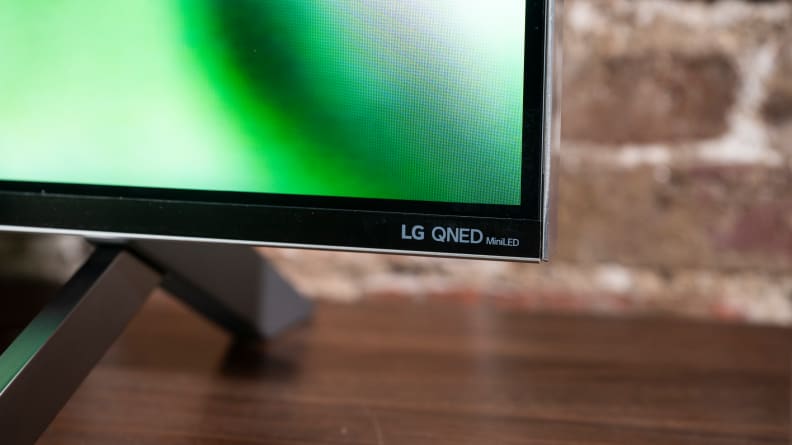
The QNED99 8K TV is only available in three sizes and none of them are small.
The LG QNED99 8K TV is available in three sizes: 65 inches, 75 inches, and 86 inches. We received a 75-inch model on loan from LG. This is how the series stacks up in terms of pricing, as of the date of publication:
- 65-inch (LG 65QNED99UPA), MSRP $2,499.99
- 75-inch (LG 75QNED99UPA), MSRP $3,499.99
- 86-inch (LG 86QNED99UPA), MSRP $5,299.99
Differently-sized TVs belonging to the same series tend to perform similarly, and we don’t expect there to be major differences in performance between each size in the QNED99 series. That said, there are most likely differences in the total number of mini-LED backlight zones depending on the model. Dimming zone count tends to increase proportionately with screen size, so contrast performance may vary slightly from one size to the next.
Here’s a rundown of the hardware and software features shared by all three sizes in the series:
- Resolution: 8K (7,680 x 4,320)
- Panel type: IPS (in-plane switching)
- Display type: Mini-LED with quantum dots
- Dimming technology: Full-array with local dimming
- HDR support: Dolby Vision, HDR10, HLG
- Dolby Atmos: Yes (native decoding)
- eARC support: Yes
- Native refresh rate: 120Hz
- Smart platform: webOS 6.0
- Color: DCI-P3 color space/10-bit chroma resolution
- Processor: α9 Gen4 AI Processor 8K
- Variable Refresh Rate (VRR): No
- Auto Low Latency Mode (ALLM): Yes
- Other features: Filmmaker Mode, Game Optimizer, Google Assistant, Amazon Alexa, Apple AirPlay2, Apple HomeKit
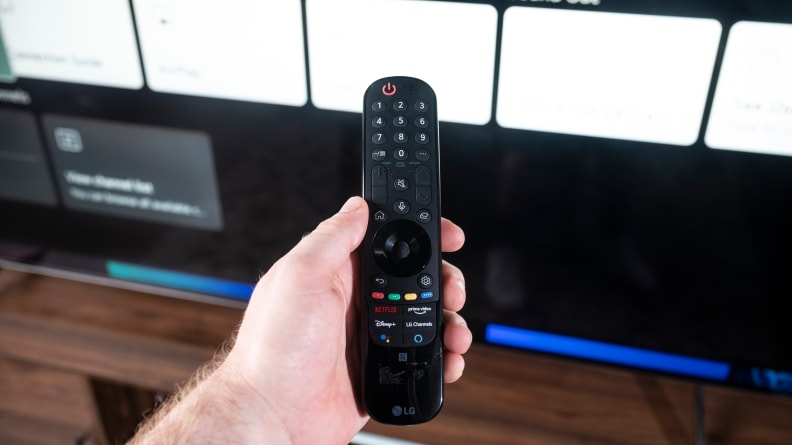
The LG QNED99 8K TV comes with the newest version of LG's Magic Remote.
Included with the QNED99 is LG’s Magic Remote, which allows users to point, click, and scroll through menus and smart features using an on-screen cursor.
Performance data
Before testing each TV, we make sure the panel is on and receiving a continuous signal for at least 24 hours, allowing the pixels plenty of time to warm up. Our 75-inch LG QNED99 received this standard warm-up time before any readings were taken.
For SDR tests, we used LG’s “ISF Expert (Bright Room)” picture mode. For HDR tests, we used the “Cinema” picture mode. We’ve chosen these picture modes because of their accuracy, but performance may vary depending on which picture mode is enabled. For example, you’re likely to experience a brighter picture with different settings enabled, but it may interfere with color temperature and overall color accuracy.
To get a sense for the TV’s average performance, we use a standard ANSI checkerboard pattern for most of our basic contrast tests. We also use white and black windows ranging from 2% to 90% to test how well the contrast holds up while displaying varying degrees of brightness.
Our peak brightness measurements are taken with sustained windows to represent the TV’s peak brightness over a sustained period of time. Specular highlights (like brief flashes of reflected light) might reach higher brightness levels, but not for a sustained period of time.
All of our tests are created with a Murideo Seven signal generator and tabulated via Portrait Displays’ Calman Ultimate color calibration software. I'll expand on our test results throughout the review, but for now, here are some key takeaways:
• HDR contrast (brightness/black level): 696.2 nits/0.202 nits (ANSI checkerboard) • SDR contrast (brightness/black level): 177.2 nits/0.061 nits (ANSI checkerboard) • HDR peak brightness (sustained): 1,170 nits (20% white window) • HDR color gamut coverage (DCI-P3/10-bit): 95% • SDR color gamut coverage (Rec.709): 100%
These tests were carried out with “Black Level” set to “Auto,” “Motion Eye Care” disabled, and, in the case of HDR tests, “HDR Tone Mapping” was enabled by default. “LED Local Dimming” was set to “Low” for testing, but this setting was adjusted to “Medium” and “High” over the course of my time with the TV.
Connectivity
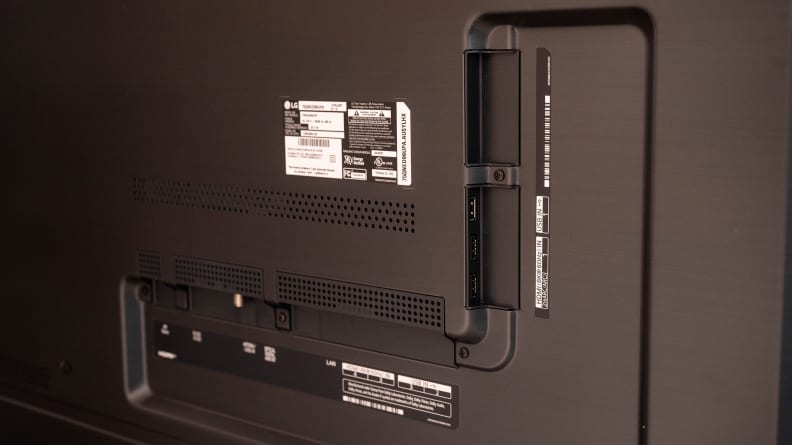
All of the TV's HDMI ports are HDMI 2.1 and are capable of displaying 4K at 120Hz and 8K at 60Hz.
The QNED99 features four total HDMI ports and all of them are HDMI 2.1. They support 8K at 60fps, 4K at 120fps, and Auto Low Latency Mode.
Here’s what you’ll find in a small, L-shaped cutout in the back of the TV’s panel:
- 4x HDMI 2.1 (1x eARC)
- 3x USB 2.0
- RF connection (cable/antenna)
- Ethernet (LAN) input
- Digital audio output (optical)
- IR Blaster
- RS-232C input
What we like
Spectacular brightness and surprisingly deep black levels
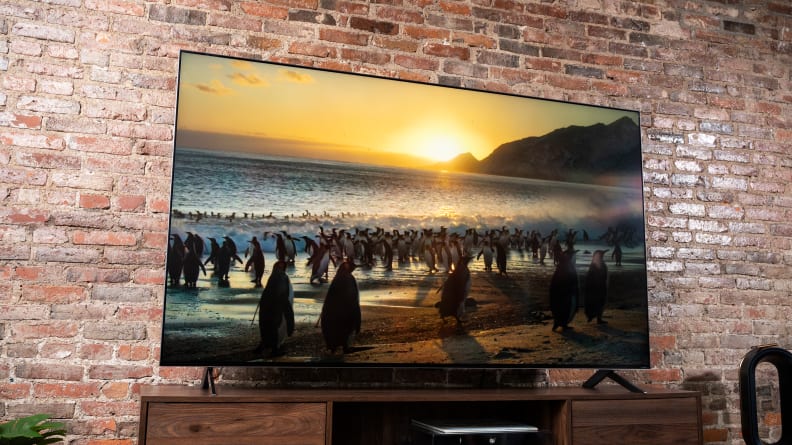
The combination of quantum dots and mini-LED backlighting makes for a terrific picture.
Before we get into black levels, a word about panel type: Like most of LG’s LCD/LED TVs, the QNED99 uses an IPS (in-plane switching) panel. The vast majority of LED TVs on the market today use VA (vertical alignment) panels.
Without delving into too much detail about these panel types, VA-style panels typically produce better contrast by way of deeper black levels but they do so at the expense of wide viewing angles. Conversely, IPS-style panels can struggle to produce black levels as deep as those found on most VA panels. The upside is that IPS panels usually enjoy wider-than-average viewing angles.
Because of this, I was not expecting the QNED99’s black levels to dip as deep as they do. In fact, the readings I’ve taken are downright impressive for an IPS panel: between 0.061 and 0.202, with the upper end of that range representing HDR content. These black levels aren’t as deep as we’ve seen on VA panels that also use mini-LEDs (the Samsung QN90A's VA panel drops as low as 0.059 in HDR, for example), but given the nature of IPS panels, they’re quite commendable.
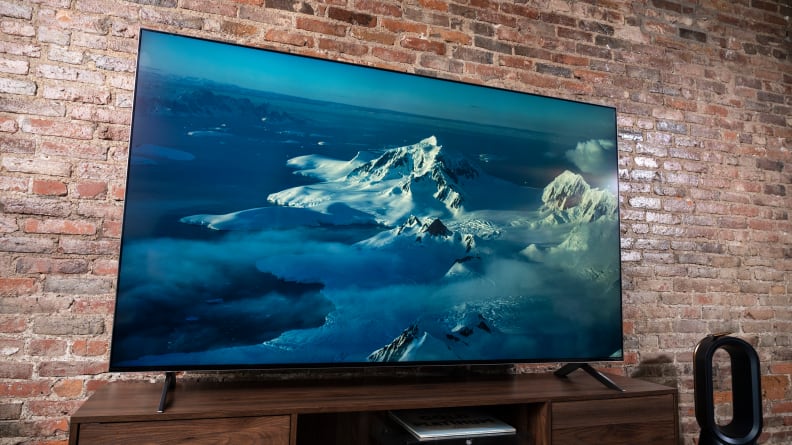
The QNED99's IPS-style panel doesn't often get as dark as a VA-style panel, but its black levels are deeper than I expected them to be, and the TV's brightness goes a long way towards offsetting them.
The reason for the TV’s relative success in this department has plenty to do with the QNED99’s aforementioned mini-LED backlighting, which introduces far more local dimming zones than traditional full-array LED TVs. They’re able to do this because of their smaller stature—the more LEDs you can fit in the panel, the more control you’ll have over the luminance of any one section of the display (ideally).
The QNED99’s combination of blistering highlights and modest black levels works because the TV is capable of getting bright enough to offset black levels that would otherwise wear their relatively shallow depth on their sleeve. It’s exciting to see the formula play out, especially in HDR. There are brighter TVs on the market—the Samsung QN90A and the Hisense U8G immediately come to mind—but unless you’ve got a particularly bright living room, the difference probably won’t matter.
Terrific color production
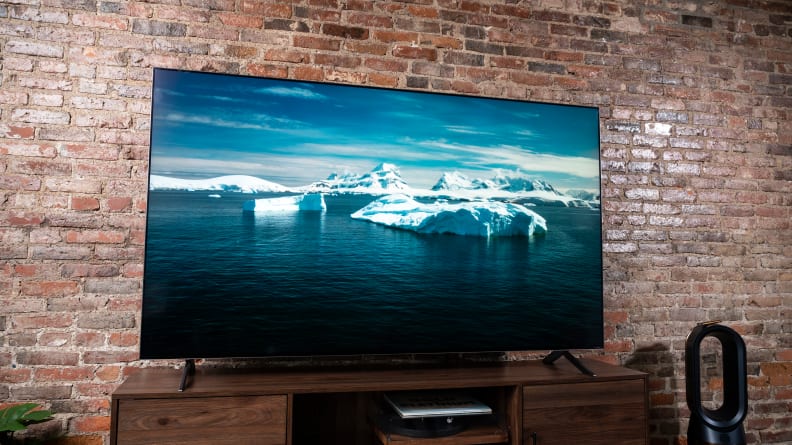
The QNED99 is capable of producing bright, rich color, and it has quantum dots to thank for that.
In addition to its use of mini-LEDs, the QNED99 is also rolling into town with quantum dots—microscopic nanocrystals that enhance a display’s color by allowing for highly saturated reds and greens.
Thanks in part to the panel’s sheer brightness, the QNED99’s quantum-dot color is wonderful to behold. Its colors are especially rich with HDR content, as the TV is capable of covering 95% of the DCI-P3 color gamut (for reference, lots of HDR content is mastered for 100% of the DCI-P3 color space). This leads to voluminous color shading.
We’ve seen plenty of mid-range QLED TVs that pump out great color thanks to the addition of quantum dots, such as TCL's 6-Series, but the display technology truly pops on a TV like the QNED99 thanks to the impressive hardware supporting those quantum dots.
It’s not perfect, but the upscaling gets the job done
Native 8K content (video that's been shot/mastered in 8K) is still very hard to come by, let alone native 8K HDR content. Outside of some sizzle reel-style clips on YouTube (which typically consist of photogenic landscapes and colorful animals), there’s just not much at your fingertips to showcase the QNED99’s 8K resolution.
Because of this, a 2021 8K TV’s ability to upscale both 4K and Full-HD (1080p) content is paramount to its everyday performance. After all, the vast majority of what folks will be watching on an 8K TV—at least in the near future—will be in native Full-HD and 4K resolution. Fortunately, the QNED99 manages to upscale this content fairly well, even if there are some hitches here and there.
To get a sense for this, I watched a few hours of broadcast television, as well as several Full-HD and 4K movies. I specifically chose the 2002 film Catch Me If You Can and 2010’s Inception, as these were two Full-HD titles I watched on the last 8K TV I reviewed, the TCL 6-Series. The QNED99 upscaled these movies relatively well, despite there still being visual evidence of the upscaling process.
To my eye, the QNED99 upscales 1080p content slightly better than the 8K 6-Series—edges are less fuzzy and shadow details are better maintained. 4K content, on the other hand, looks tremendous, with almost no noise or fuzziness to speak of. All told, the QNED99 upscales Full-HD content better than the TCL 8K 6-Series, but both TVs perform roughly the same when processing a 4K image.
Minimalist design

The QNED99's panel is impressively thin given the complexities of the display technology held within.
The design of the QNED99, while not flashy, is nevertheless fetching—especially if you appreciate a minimalist approach. Its ultra-narrow bezels put the picture front and center, and the TV’s metallic frame gives an air of sophistication.
The panel itself is quite thin, given the complexities of its internal hardware. Its sleek profile makes it a great candidate for wall-mounting, but should you opt for a table or TV stand, its slender build is still easy to appreciate. The QNED99’s thin, angular feet almost disappear in dark environments, though you'll need to be careful as you move the set as they're liable to scratch softer surfaces.
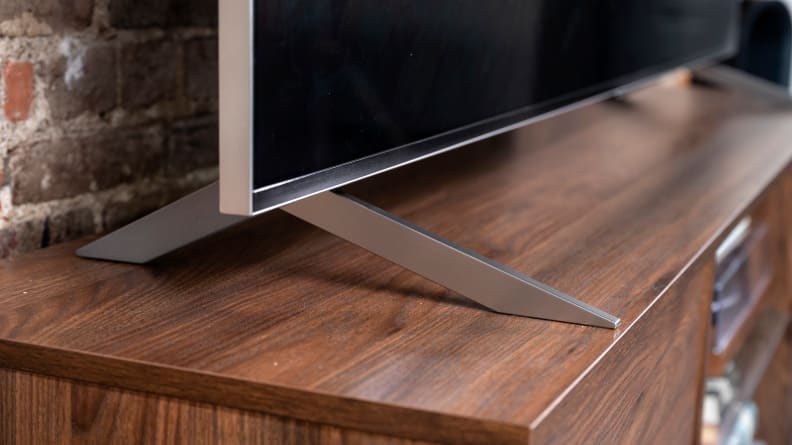
The TV's razor-thin feet do not draw attention to themselves—and that's a good thing.
What we don’t like
Plenty of light bloom, particularly during off-angle viewing
If the QNED99 is hiding an Achilles heel, it comes in the form of light bloom. These are small-to-medium-sized clouds of light that flank various picture elements, depending on how bright those elements are in relation to the rest of the picture.
Due to the sheer number of mini-LED zones and the speed with which they brighten and dim, the light bloom I witnessed was quite animated—and distracting. This could be seen during both SDR and HDR content, though HDR content seemed to punctuate the effect on account of how bright the TV’s specular highlights are capable of getting. I even cycled through the TV’s “LED Local Dimming” setting, but the issue was present whether that setting was tuned to “Low,” “Medium,” or “High.”
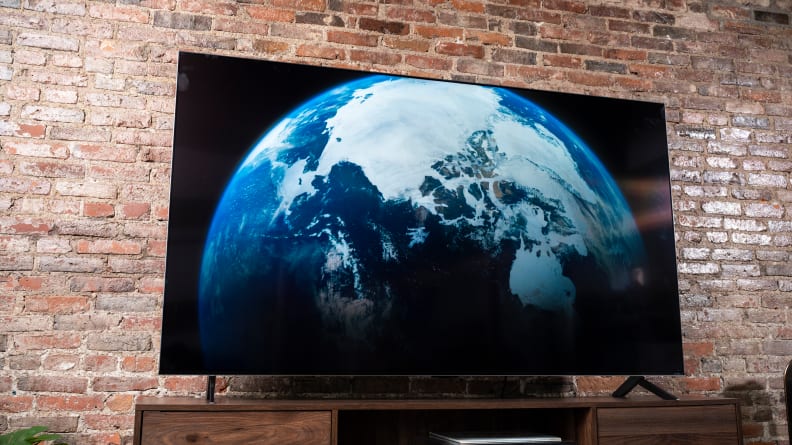
While it's not readily apparent in this photo, the QNED99 struggles with off-angle viewing on account of the number of mini-LEDs and the aggressive local dimming that governs them.
As mentioned, the QNED99’s IPS-style panel allows it to demonstrate wider-than-average viewing angles, at least when it comes to maintaining contrast and limiting color shifting. Unfortunately, the TV’s light bloom issues are often exacerbated by off-angle viewing, making this particular benefit of its IPS panel somewhat moot.
Yes, the IPS-style panel of the QNED99 is better suited for off-angle viewing in some ways. The picture maintains its color accuracy when viewed from the side and doesn’t soften too much—at least not as much as it typically would on most VA-style LED TVs. But in general, the QNED99’s bountiful array of mini-LEDs leave all of their work out in the open, and this is especially distracting when you don’t have the best seat in the house. Given that the QNED99 is only available in “big,” “really big,” and “incredibly huge” size variants, it’s important to consider what the experience might be for a room full of guests—though that should also mean that more folks have a straight-on view.
A curious lack of VRR
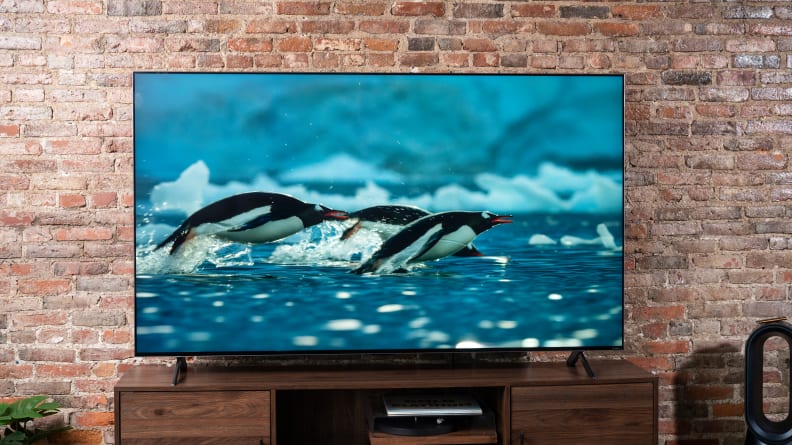
The TV's native 120Hz refresh rate, its reliably smooth motion handling, and the inclusion of HDMI 2.1 all make for a great gaming TV, but for some reason, VRR is absent.
With Auto Low Latency Mode (ALLM), HDMI 2.1, a native refresh rate of 120Hz, and above-average motion handling, the QNED99 is poised to be a great gaming companion for years to come. Weirdly, however, it’s lacking Variable Refresh Rate (VRR)—something that is included in the 4K QNED90, the TV that’s just below the QNED99 in LG’s 2021 product lineup.
VRR is a feature commonly associated with the new HDMI 2.1 standard, and one that is garnering more attention with the rise of next-gen gaming on the PlayStation 5 and Xbox Series X. Essentially, it keeps the image your TV is displaying in sync with what’s being processed, eliminating screen tearing and other visual artifacts that can otherwise distract from high-paced gaming sessions.
The QNED99 is ready to play 4K games at 120fps, and when the time comes, 8K games at 60fps, and both are impressive feats, no doubt. The absence of VRR shouldn’t affect you much if you’re not a serious gamer. But hardcore gamers may feel like they’re missing a crucial spec, which could be a deal-breaker.
Sluggish software
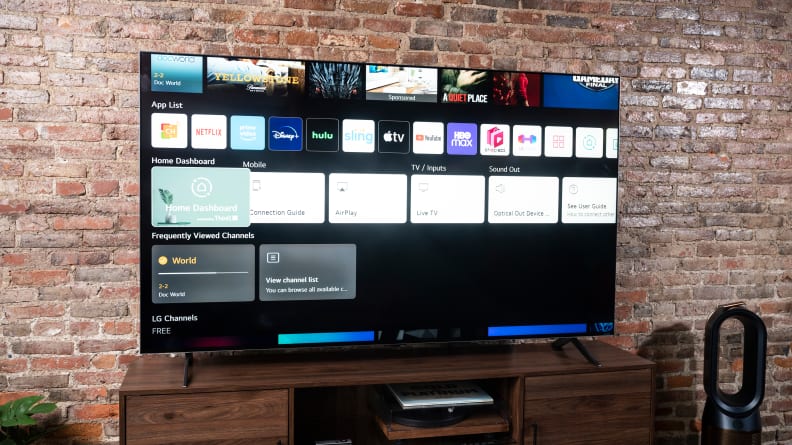
LG's webOS smart platform is customizable with its own app store, but its implementation on the QNED99 is quite sluggish.
The QNED99 experience centers around the newest iteration of LG’s webOS smart platform, which has seen some changes in recent years. Its home screen is where you’ll spend most of your time, and while there are plenty of apps and a slew of sponsored content to choose from, I found the response time of the software to be slow, which is kind of a drag for a top-shelf TV like this.
The sluggishness carries over into the TV’s various settings menus. It was a bit of a headache to make changes to the TV’s picture on the fly, as I was seemingly always inputting my selections a second or two before the inputs were actually registered by the TV.
Unfortunately, you’ll never be able to fully run away from the QNED99’s various menus, but you can easily pair the TV with a dedicated streaming device. In addition, it's possible this is something that could be addressed in a firmware update in the future.
Should you buy it?
Yes, but only if you’re committed to spending up for 8K
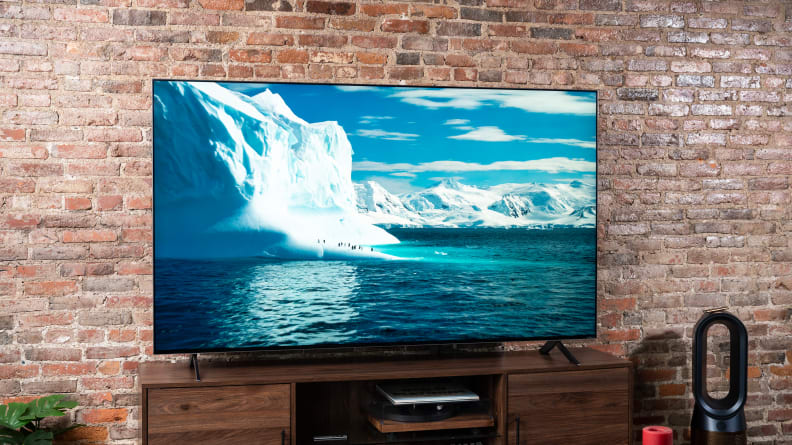
The LG QNED99 is an excellent TV, but there are more affordable TVs that look just as good (if not better), but most do not feature a native 8K resolution.
There are two ways to look at how the QNED99 stacks up against the competition: by comparing it to other 8K TVs or by comparing it to similarly priced 4K TVs.
Of the two 8K TVs we’ve reviewed so far this year (the QNED 99 and the TCL 8K 6-Series), it’s difficult to assess which is the better pick. On one hand, the QNED99 is the better performer; it’s brighter in HDR, its color production is slightly better, and it does a better job of upscaling Full-HD content. On the other hand, the TCL 6-Series’ Roku software is superior to LG’s smart platform, and the 6-Series comes bearing Variable Refresh Rate, making it a wiser choice for serious gamers.
Consider this, however: If you’re willing to break the bank for 8K on account of its posh, upscale vibe, why not spend less on a better TV? To date, the LG C1 OLED is the best TV we’ve reviewed this year, and it currently costs less than the QNED99. As an OLED TV, it doesn’t get nearly as bright as the QNED99, and it doesn’t support 8K resolution, but you probably won’t be experiencing much 8K content for the foreseeable future.
If high-octane brightness and dazzling quantum-dot color is what you’re after, the Samsung QN90A is another 4K alternative that currently costs less than the QNED99. It offers tremendous performance and all of the gaming features we’ve come to expect from high-end flagship TVs.
The LG QNED99 deserves a ton of respect for how it implements its impressive display technology. It was a pleasant surprise to see an IPS-style panel deliver contrast that's close to what I’ve come to expect from VA panels, and its upscaling abilities are among the best I’ve seen on an 8K TV. But it’s worth remembering that its 8K resolution is the biggest reason this TV is priced as high as it is, and that money goes a long way if you decide to leave 8K at the door for the time being.
Meet the tester
Michael Desjardin graduated from Emerson College after having studied media production and screenwriting. He specializes in tech for Reviewed, but also loves film criticism, weird ambient music, cooking, and food in general.
Checking our work.
Our team is here to help you buy the best stuff and love what you own. Our writers, editors, and experts obsess over the products we cover to make sure you're confident and satisfied. Have a different opinion about something we recommend? Email us and we'll compare notes.
Shoot us an email